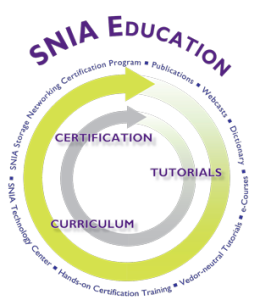 SNIA is pleased to announce the appointment of its new Executive Director, Michael Oros. A 20-year industry veteran, Michael comes to SNIA from Intel where he was instrumental in overseeing a wide range of strategic industry initiatives, and for the development and deployment of storage, backup, and disaster recovery services. He also led the formation of the Open Data Center Alliance and with the Board of Directors, established the organization’s presence and reach across six continents, with world leading members accelerating cloud adoption and transformation of the IT landscape.
SNIA is pleased to announce the appointment of its new Executive Director, Michael Oros. A 20-year industry veteran, Michael comes to SNIA from Intel where he was instrumental in overseeing a wide range of strategic industry initiatives, and for the development and deployment of storage, backup, and disaster recovery services. He also led the formation of the Open Data Center Alliance and with the Board of Directors, established the organization’s presence and reach across six continents, with world leading members accelerating cloud adoption and transformation of the IT landscape.
David Dale, SNIA Chairman, recently sat down with Michael to discuss his vision for the future of SNIA.
Dale: Michael, welcome to SNIA. We’re excited to have you on board.
Oros: Thank you David. I am honored and thrilled to be here! These are exciting times for the storage industry, and I strongly believe SNIA and the member companies are poised to be at the center of this transformation.
Dale: How long have you been involved with SNIA?
Oros: I’ve been involved with SNIA indirectly since 2000, when fibre channel interoperability was an industry challenge that I had to address for Intel’s managed storage service offerings. Since 2004, I have participated more directly starting with my first SNW event in Phoenix.
Dale: What attracted you to the Executive Director position and what excites you the most about SNIA?
Oros: The opportunity to lead, facilitate and be part of the storage industry transformation. The great people that make up the storage industry – an amazing SNIA Board of Directors that’s passionate and cares deeply, great staff and incredible volunteers; these were key attributes that I personally value and sought out.
Dale: What are the major changes forthcoming in the storage industry that SNIA needs to be actively involved with?
Oros: The flurry of M&A activity over the past couple years has already changed the storage industry landscape, and we can expect to see over the next couple years the impact and innovation coming out from these mergers/acquisitions. SNIA needs to be nimble; continue to deliver value through standards and initiatives that are of high importance and relevancy to the storage industry and the implementers/consumers of enterprise storage technologies: enterprise IT, cloud service providers and hyperscalers.
Dale: What do you think the impact of the 3rd Platform will be to the industry?
Oros: Huge! The analyst terminology referring to the third computing platform that encompasses mobile, social, cloud computing, and Internet of Things, is driving an increase in both storage demand and efficiency. As billions of users/devices and millions of apps interact on this “3rd Platform”, IT organizations have to change how they do business and manage this exponential increase in assets, data they are generating and its security. The storage industry and vendors have to innovate and deliver solutions that are lower touch to deploy and manage, more flexible and adaptable to an array of applications and security requirements.
Dale: What do you see as SNIA’s top goals for 2016?
Oros: Continue to be relevant in our work to the industry and our member companies, execute on the technology specifications, and grow the organization.
Dale: One week in the role, what are your initial thoughts and plans?
Oros: First, a big thank you to everyone for their help and support as I’ve come on board! I’ve started working with the team to ensure the member companies have the best resources and tools available to collaborate on technology specifications and initiatives – myself and all SNIA staff are here to support our members and delight our wonderful industry volunteers. Business development and outreach will see an increase in activity. And marketing programs are being planned in addition to our events, to promote loudly and with clarity the vital work SNIA and member companies are doing!
To learn more, read the official SNIA press release.
 The Storage Networking Industry Association (SNIA) is the largest storage industry association in existence, and one of the largest in IT. It is comprised of over 170 leading industry organizations, and 2,500 contributing members that serve more than 50,000 IT and storage professionals worldwide.
The Storage Networking Industry Association (SNIA) is the largest storage industry association in existence, and one of the largest in IT. It is comprised of over 170 leading industry organizations, and 2,500 contributing members that serve more than 50,000 IT and storage professionals worldwide.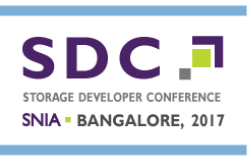 For the third consecutive year, SNIA will present their highly successful
For the third consecutive year, SNIA will present their highly successful  By George Ericson, Distinguished Engineer, Dell EMC; Member, SNIA Scalable Storage Management Technical Working Group, @GEricson
By George Ericson, Distinguished Engineer, Dell EMC; Member, SNIA Scalable Storage Management Technical Working Group, @GEricson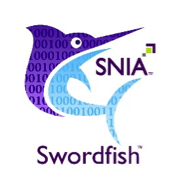
 February 14-17 2017, join SNIA in San Francisco at the
February 14-17 2017, join SNIA in San Francisco at the  The following week, February 21-23, join SNIA at
The following week, February 21-23, join SNIA at  Closing out February, find SNIA at their booth at
Closing out February, find SNIA at their booth at 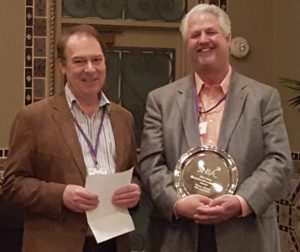 With the Exceptional Leadership award, SNIA recognizes an individual who has advanced a cause for SNIA leading to an impact on the industry or the Association. Past winners have included Wayne Adams of EMC, Eric Hibbard of Hitachi, and Paul von Behren of Intel. SNIA also recognizes unsung heroes who work tirelessly under the radar expecting no attention but who in fact probably deserve more than the rest, and new contributors of the year who begin work in new areas.
With the Exceptional Leadership award, SNIA recognizes an individual who has advanced a cause for SNIA leading to an impact on the industry or the Association. Past winners have included Wayne Adams of EMC, Eric Hibbard of Hitachi, and Paul von Behren of Intel. SNIA also recognizes unsung heroes who work tirelessly under the radar expecting no attention but who in fact probably deserve more than the rest, and new contributors of the year who begin work in new areas. Previous recipients have been acknowledged for their work in Persistent Memory, Solid State Storage, Storage Management, and Object Drives, and with SNIA India and the SNIA Global Steering Committee. A list of all individuals and groups recognized since 2008 can be found at
Previous recipients have been acknowledged for their work in Persistent Memory, Solid State Storage, Storage Management, and Object Drives, and with SNIA India and the SNIA Global Steering Committee. A list of all individuals and groups recognized since 2008 can be found at 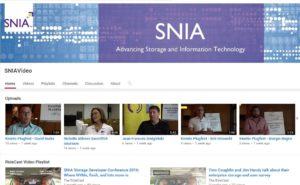

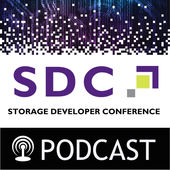 can get a “sound bite” of what to expect by downloading SDC podcasts via
can get a “sound bite” of what to expect by downloading SDC podcasts via 